Defining the Extracellular Matrix of Rhabdomyosarcoma
- PMID: 33708626
- PMCID: PMC7942227
- DOI: 10.3389/fonc.2021.601957
Defining the Extracellular Matrix of Rhabdomyosarcoma
Abstract
Rhabdomyosarcoma (RMS) is the most common soft-tissue sarcoma of childhood with a propensity to metastasize. Current treatment for patients with RMS includes conventional systemic chemotherapy, radiation therapy, and surgical resection; nevertheless, little to no improvement in long term survival has been achieved in decades-underlining the need for target discovery and new therapeutic approaches to targeting tumor cells or the tumor microenvironment. To evaluate cross-species sarcoma extracellular matrix production, we have used murine models which feature knowledge of the myogenic cell-of-origin. With focus on the RMS/undifferentiated pleomorphic sarcoma (UPS) continuum, we have constructed tissue microarrays of 48 murine and four human sarcomas to analyze expression of seven different collagens, fibrillins, and collagen-modifying proteins, with cross-correlation to RNA deep sequencing. We have uncovered that RMS produces increased expression of type XVIII collagen alpha 1 (COL18A1), which is clinically associated with decreased long-term survival. We have also identified significantly increased RNA expression of COL4A1, FBN2, PLOD1, and PLOD2 in human RMS relative to normal skeletal muscle. These results complement recent studies investigating whether soft tissue sarcomas utilize collagens, fibrillins, and collagen-modifying enzymes to alter the structural integrity of surrounding host extracellular matrix/collagen quaternary structure resulting in improved ability to improve the ability to invade regionally and metastasize, for which therapeutic targeting is possible.
Keywords: COL18A1; PLOD1/2; matrix; rhabdomyosarcoma; survival.
Copyright © 2021 Lian, Bond, Bharathy, Boudko, Pokidysheva, Shern, Lathara, Sasaki, Settelmeyer, Cleary, Bajwa, Srinivasa, Hartley, Bächinger, Mansoor, Gultekin, Berlow and Keller.
Conflict of interest statement
Authors ML and GS are employed by the company Omics Data Automation. The remaining authors declare that the research was conducted in the absence of any commercial or financial relationships that could be construed as a potential conflict of interest.
Figures








References
LinkOut - more resources
Full Text Sources
Other Literature Sources
Molecular Biology Databases
Miscellaneous

